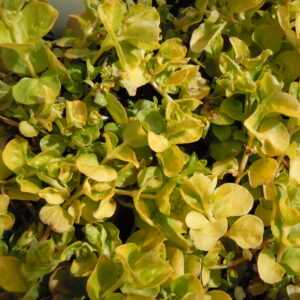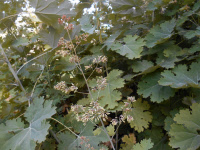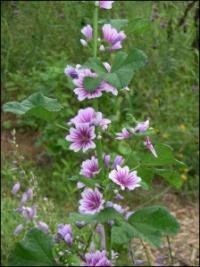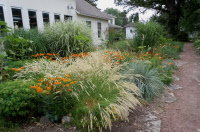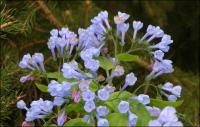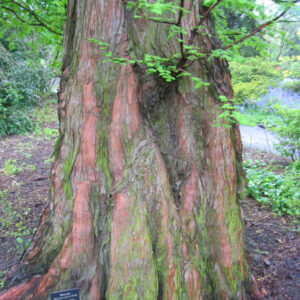Our Plants
Showing 377–384 of 587 results
-
Lysimachia nummularia ‘Aurea’ Creeping jenny Z 3-9
Bright yellow flowers in summer, chartreuse foliage which is the reason to grow this.
Bright yellow flowers in summer & chartreuse foliage which is the reason to grow this.
Size: 2” x spreading
Care: full sun to part shade in moist to moist well-drained soil
Native: Europe
Awards: England’s Royal Horticultural Society Award of Garden Merit.Dioscorides (1st century A.D.) named Lysimachia after King Lysimachus of Thracia. By the 1590’s used as cure for wounds and whooping cough. Species listed in Gardeners Dictionary, 1768. ‘Aurea’, H.H. Thomas 1915. Breck (1851) called this “suitable for rockwork or hanging from a pot in a northern exposure.” L.H. Bailey echoed this: “Very useful for rustic vases and baskets, also for carpeting ground in shady places.”
-
Macleaya cordata Plume poppy Z 4-9
An imposing plant - impressive, glaucous leaves with conspicuous veins and jagged margins, and, from July to October, tawny pink plumes.
An imposing plant – impressive, glaucous leaves with conspicuous veins and jagged margins, and, from July to October, tawny pink plumes.
Can not ship to: Delaware and Maryland
Size: 6-8' x 3' and spreading
Care: sun in well-drained to moist well-drained soil
Native: China and JapanEnglish seaman on Macartney’s Chinese mission sent this to Europe in 1792. In its native China the plant’s juice disinfected insect bites. Grown in American gardens since the 1800’s.
-
Malva alcea ‘fastiagata’ Hollyhock mallow Z 5-9
Bright rose mallows from early to late summer. Cut back by half in late July for rebloom.
OUT OF STOCK
Bright rose mallows from early to late summer. Cut back by half in late July for rebloom.
Size: 3’ x 18”
Care: Sun well-drained soil, drought tolerant
Native: ItalyMalvas have been cultivated for food or flower since 6000 B.C. In 1629 Parkinson described the uses for the Hollyhock mallow: “By reason of their viscous or slimie quality doe helpe to make the body soluble… helpe also to ease the paines of the stone and gravell, causing them to be the more easily voided: being outwardly applied, they mollisie hard tumors.”
-
Malva sylvestris ‘Zebrina’ Striped mallow – According to the books a perennial, but here it acts like an annual that reseeds – just watch for the seedlings in early summer. Z 5-8
June to October pink with purple striped mallow flowers
June to October pink with purple striped mallow flowers
Size: 36-48" x 24"
Care: Sun, moist well-drained soil. Moderately fertile.Malvas have been cultivated for food or flower since 6000 B.C. This was identified by Dioscorides in De Materica Medica for medicinal use around 70 A.D. Flowers and young leaves are edible – add petals to salads. The Malva sylvestris ‘Zebrina’ was listed as cultivated in the empire pursuant to Charlemagne’s Capitulare de Villis c. 800 A.D. The French word “mauve” comes from the color for this flower. Pressed specimen in Emily Dickinson’s herbarium.
-
Matteuccia struthiopteris Ostrich fern Z 3-7
Dissected, feathery fronds resemble ostrich plumes form vase-shaped clumps.
Dissected, feathery fronds resemble ostrich plumes form vase-shaped clumps.
Size: 3-4’ x 5-8’ spreading by rhizomes.
Care: part to full shade in moist well-drained to moist soil
Native: eastern No. America, Wisconsin nativeIn gardens before 1790. Matteuccia is named to honor Italian scientist Carlo Matteucci (1811-1866.) Struthiopteris comes from struthio meaning “ostrich” and pteris meaning “fern.” The fronds are edible – Vermont adopted this as its state vegetable.
-
Melica ciliata Silky spike melic grass Z 5-9
Ornamental arching white spikes from June through mid-summer. Especially nice for its early bloom, long before most grasses.
Ornamental arching white spikes from June through mid-summer. Especially nice for its early bloom, long before most grasses.
Size: 2' x 12"
Care: full sun in moist well-drained to moist soil.
Native: Eurasia to North Africa
Wildlife Value: Deer resistantMelica is Greek for “sweet grass.” This species collected before 1753.
-
Mertensia virginica syn. Mertensia pulmonarioides Virginia bluebells Z 3-7
Clusters of pink buds turn to sky blue trumpets in May. Ephemeral, disappearing in summer to return next spring.
Available for purchase in Spring only
Clusters of pink buds turn to sky blue trumpets in May. Ephemeral, disappearing in summer to return next spring.
Size: 18" x 10" spreads slowly
Care: Moist well-drained soil in part shade.
Native: N.Y. to Tennessee, west to Kansas, Wisconsin native
Wildlife Value: Provides nectar and pollen to honeybees, bumble and mason bees, as well as Skipper butterflies and Sphynx moths. Deer resistant.
Awards: Royal Horticultural Society Award of Merit.Cherokee cured whooping cough and consumption with Virginia bluebells. Other Natives treated whooping cough, venereal disease, and plain poor health with this. First collected for gardens by John Banister in colonial Virginia C. 1690. Named Mertensia after Franz Karl Mertens (1764-1831), a German botanist who never set foot in America. Grown by both Washington and Jefferson.
-
Metasequoia glyptostroboides Dawn redwood Z 4-8
Fast-growing, pyramidal-shaped deciduous conifer.
Fast-growing, pyramidal-shaped deciduous conifer. The orange to brown trunk base tapers and thickens with up to a dozen large buttress-like root flares extending several feet up the trunk. Feathery, fern-like, soft foliage emerges light green in spring, and turns red-bronze in fall before dropping. Its branches are well-attached and make excellent climbing.
Size: 70-90’ x 15-25’
Care: sun in moist to moist well-drained, slightly acid soil
Native: Szechuan China
Awards: Royal Botanic Garden Award of Garden Merit, Yew Dell Botanical Gardens’ Theodore Klein Plant Awards & Pennsylvania Horticultural Society GoldFrom fossil records, dawn redwood is known to have existed as many as 50,000,000 years ago. However, it was not until 1941 that dawn redwood was first discovered growing in the wild near the town of Modaoqi China by Chinese forester, T. Kan. Seeds collected from the original site were made available to the Missouri Botanical Garden in 1947. Seedlings grown therefrom were planted in front of the Lehmann Building at MBG in 1952 where they have now developed into large mature trees (70’+ tall). Dawn redwood is a deciduous, coniferous tree that grows in a conical shape to 100’ tall. It is related to and closely resembles bald cypress (Taxodium) and redwood (Sequoia).

